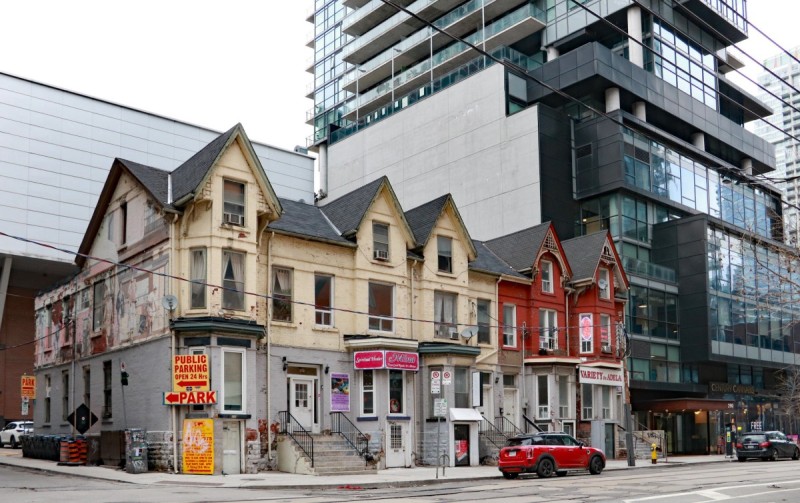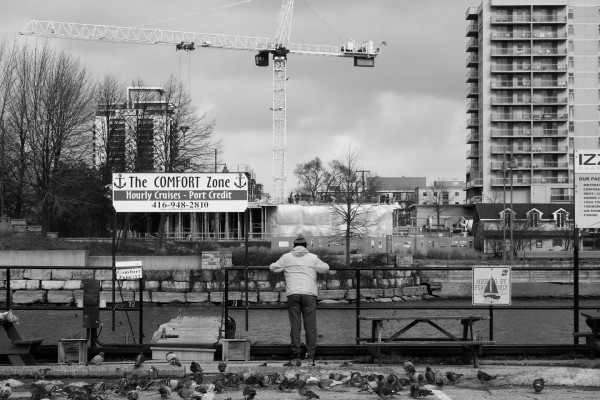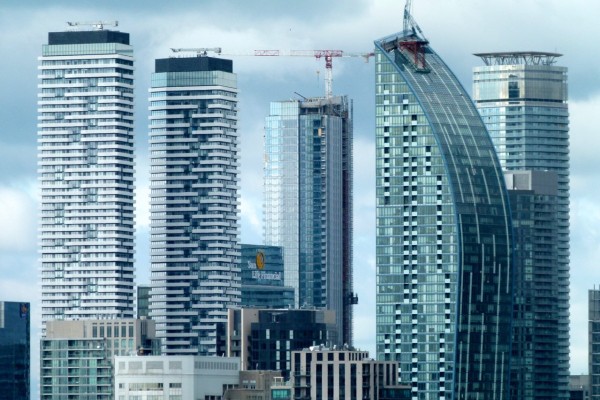Two housing crises in one city
The beneficiaries of upscale redevelopment and parasitic speculation are now experiencing a calamity of their own

Toronto’s disappearing mid-century architecture is increasingly dwarfed by glass-and-steel condos built for investors, not occupants. Photo by Can Pac Swire/Flickr.
I’ve previously written for Canadian Dimension about a housing struggle I am involved in around a vacant site in Toronto’s Downtown East. Our community-based organization, 230 Fightback, is challenging the developer KingSett Capital’s plans to build luxury housing at 214-230 Sherbourne Street, and demanding that social housing be created instead.
Faced with relentless community pressure and a faltering housing market, KingSett offered to sell the site to the city but only at a price that would cover the costs of its speculative antics. For its part, city hall adamantly refused to apply the kind of pressure that could compel the company to reduce the price.
For over a year now, despite our best efforts, the impasse has continued and this property, located in an area with the most pressing housing needs, remains vacant, as it has done for the past 17 years. This glaring injustice flows from a situation in which housing is provided on the basis of greed, speculation and profit-making, rather than rationally meeting the needs of communities.
Parallel crises
We often speak of a “housing crisis” and it is certainly true that profit-driven housing provision means rapidly intensifying hardship for hundreds of thousands of people in Toronto alone (and millions Canada-wide). However, the beneficiaries of upscale redevelopment and parasitic speculation are now experiencing a crisis of their own, as the speculative bubble they’ve created bursts spectacularly. Two housing crises are unfolding in one city.
Last July, Royal LePage’s 2024 Canadian Renters Report found that almost a fifth of tenants in Ontario, and especially the Greater Toronto Area, were devoting half their income or more to paying their rent. At the same time, 36 percent of Ontario tenants had to hand over between 31 and 50 percent of their income to landlords. As BlogTO pointed out, “Allocating no more than 30 per cent of wages to housing is generally considered the standard for comfortable living in Canada.”
In such a situation, it is hardly surprising that hunger and homelessness are intensifying dramatically. At the end of last year, the Daily Bread Food Bank reported that “From April 1, 2023, to March 31, 2024, Toronto food banks served a record-breaking 3.49 million client visits—almost one million more than last year.” This translates into a tenth of the city’s population having to turn to private charity to obtain food. Moreover, “more than ever, we are seeing individuals who had never considered using food banks walking through our doors and accessing our emergency services for the very first time.”
In January, the Association of Municipalities of Ontario (AMO) reported that there had been a 25 percent increase in homelessness in Ontario in the space of one year. It also took note of how rapidly the situation is deteriorating and suggested that, by 2035, homelessness could more than triple, leaving nearly 300,000 people without stable housing.
There are several major factors behind this shameful state of affairs but the extreme lack of truly affordable housing is obviously a key consideration. It must also be noted that these statistics don’t take into account the severe impacts of the present trade war that will intensify these problems dramatically. It is being widely predicted that the imposition of tariffs and counter tariffs will drive up consumer prices and lead to large-scale unemployment. Both of these would impact the housing crisis very seriously.
Now that the seemingly endless bonanza of speculation that created this situation has come to a shuddering halt, developers like KingSett Capital are reeling and their sources of profit are threatened. Their problems may not upset us unduly but the dimensions of this crisis and its implications for those who seek to obtain or retain housing are worth exploring.
In November of last year, BNN Bloomberg reported that “KingSett Capital Inc. suspended payments to investors in a large Canadian property fund, saying it needs to hoard cash as it deals with the consequences of the sector’s long slump.” Putting a brave face on the situation, KingSett CEO Rob Kumer blustered that “In this environment, the right thing to do is to retain liquidity and fortify our balance sheet so that we are well positioned to generate growth in the recovery that will follow.”
Shortly before this, Storeys reported that KingSett was retreating from plans to build a 69-storey condo tower on Isabella Street in Toronto. The article noted that for “the second time in the past seven days, a high-profile high-rise project in Toronto has been made available for purchase by the developer, in what’s likely a reflection of the uncertainty around overall market conditions.” By the end of last year, the long condo boom that has had such an impact on Toronto was over and the inevitability of the crash is easy to discern.
The bubble bursts
A curious by-product of the travails of the housing market is the emergence of candid insiders who like to make videos that chart the process by which the collapse occurred and stress how bleak the situation is. One such effort, produced by Fox Marin Associates Limited, is titled “No one saw this coming! Toronto real estate slowdown.” It features an interview with real estate lawyer Mark Morris, who has some interesting things to say.
Morris points out that, since 2006, home prices have increased considerably quicker than average incomes but this process has spun out of control since the pandemic (3:30). He maintains that, in 2019, the federal government compounded the problem by working to increase the money supply and the ability to participate in the housing market. This “pushed up asset values massively” (4:09). Morris explains that the rapidly expanding housing bubble was now concentrated in new build construction and particularly in the rapid creation of condos. As this process unfolded, the supply of condos became increasingly responsive, not to the housing needs of those who might live in the units, but to investors who would buy them for purely speculative purposes. In this situation builders were focusing on providing small but unlivable condo units that best met the needs of investors (4:20).
As this obviously doomed undertaking continued, it reached the point where “the only reason really from 2017 onward that anything sold was because everyone kind of recognized that they could take advantage of the bubble that had been created” (5:16). Inevitably, however, this feeding frenzy has finally succumbed to reality, with investors pulling out and condo buyers walking away in increasing numbers.
Morris estimates that a quarter of buyers who purchased pre-construction condos are currently defaulting and he expects this to rise. Later in the video he notes that “At some point it actually becomes the builder’s problem, not just the buyer’s problem, and… if enough of them start defaulting it becomes the bank’s problem” (17:30). As he puts it, the speculative bubble that has been inflated by a scramble for profits has “definitively popped.”
The process Morris describes is an irrational and massively deficient way for a society to respond to the housing needs of its population. For years now, housing advocates have confronted an unjust system that was generating vast profits but we are now challenging that same system as it shudders to a halt. We must see this as an opportunity to break the grip of the developers and speculators and defeat the established political orthodoxy that holds that housing provision requires the incentivization of these parasitic interests.
All levels of government are complicit in this. And as condo construction freezes and buyers walk away, developers hope that governments will provide them with inducements to build private rental housing that will be as slanted towards the high-end buyers and investors. City Flats ran an article last September that noted “For developers and investors (the rental market) presents a lucrative opportunity, especially when paired with the various incentives available to make apartment building projects more viable and profitable.”
It would be naïve in the extreme to imagine that those who have profited from the financialization of housing will change their behaviour or that the political decision makers will willingly put the needs of communities ahead of the profit motive. It will require mass action and a determined movement to win change.
On April 25 and 26, a Peoples’ Assembly for Housing justice was held in Toronto. Hundreds of people participated and some 14 community-based organizations worked together to make it happen. On June 14, those same organizations will be mobilizing for an action that will start at the vacant site at 214-230 Sherbourne and march into the financial district to confront the corporate landlords and developers whose stranglehold we must break.
A movement for housing justice is emerging in Toronto and across the country. As the impacts of the trade war make the situation even more dire we must advance fighting demands around rent control, putting an end to demovictions, a moratorium on economic evictions and a massive transfer of public resources towards the creation of social housing. For too long, housing has been treated as a commodity but it must become a social right that is the cornerstone of a healthy and just society.
John Clarke is a writer and retired organizer for the Ontario Coalition Against Poverty (OCAP). Follow his tweets at @JohnOCAP and blog at johnclarkeblog.com.










